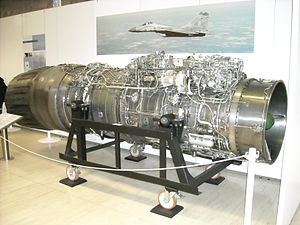User:SidewinderX/Sandboc/Kilmov RD-33
| RD-33 | |
|---|---|

| |
| RD-33 | |
| Type | Turbofan |
| Manufacturer | Klimov |
| First run | 1985 |
| Major applications | Mikoyan MiG-29 |
The RD-33 turbofan engine was developed in 1985 to power the Mikoyan MiG-29 fighter. It is an 8000-9000 kgf thrust class turbofan twin-shaft engine with afterburner built by the Klimov company of Russia and has several variants. It features a modular design, individual parts can be replaced separately and has a good tolerance to the environment. The RD-33 is simple to maintain and retains good performance in challenging environments.[1]
Variants[edit]
Years of development has built an extensive engine family. A newly designed thrust vectoring nozzle (TVN) is now available. New models of the RD-33 family include BARK digital monitoring and control systems. Repair and maintenance of RD-33 engines takes advantage of an information and diagnostics system (IDS).
RD-33[edit]
Baseline model developed in 1985 to power the MiG-29.
RD-33B/NB[edit]
A model without afterburner for various types of aircraft.
RD-93[edit]
A variant used to power the JF-17 / FC-1. According to JF-17.com "The most significant difference being the repositioning of the gearbox along the bottom of the engine casing."
SMR-95[edit]

A model for upgrading international 2nd and 3rd generation jet fighters. The accessory gearbox is repositioned below the engine, length can be varied depending on the adopted aircraft fuselage. The engine passed bench tests and flight tests on the Super Mirage F-1 and Super Cheetah D-2 aircraft of the South African Air Force and had achieved an improvement in flight performance and combat efficiency by a factor ranging from 1.2 to 3.0.[2]
RD-33 series 3[edit]
A revised model with a longer service life used on later or upgraded old variants of the MiG-29 such as MiG-29M and MiG-29SMT.[3][4] A pair of RD-33 series 3 engine equipped with TVN is currently undergoing flight tests as a component of the MiG-29OVT jet fighter.[5]
HAL series 3[edit]
In 2005, Russia signed a $250 million deal with India to modernize engines for the MiG-29 fighters of the Indian Air Force. According to the terms of the deal, Hindustan Aeronautics Ltd (HAL) will make 120 RD-33 series 3 jet engines at its Koraput plant for the upgrade of MiG-29 fighters. The engine designer, St. Petersburg-based Klimov, is also one of the players in the deal with India. Both of them are part of the RAC MiG corporation. In the first stage HAL is expected to make 120 engines, which would cost less than those directly bought from Russia. This deal would help HAL master the assembly of next generation jet engines, including RD-33MK (Sea Wasp) engines for deck based MiG-29K naval fighters being acquired under the Gorshkov aircraft carrier deal. It will also help develop thrust-vectoring engines for the MiG-35 fighters, which Russia is fielding for US $12 billion Indian tender for 126 advanced combat jets.
RD-33MK[edit]
The RD-33MK "Morskaya Osa" (Russian: Морская Оса: "Sea Wasp") is the latest model developed in 2001. Itit is intended to power the MiG-29K and MiG-29KUB shipborne fighters, however it is has also been adopted for the MiG-35. The RD-33MK develops 7% higher, increased afterburner thrust to 9,000kgf and dry weight 1145 kg compared to the baseline model through modern materials used on the cooled blades, although it retains the same length and maximum diameter. Incorporated are a infrared and optical signature visibility reduction systems. Service life has been increased to 4,000 hours. The RD-33MK ensures shipborne fighters unassisted take-off capability, retain performance in hot climate environment and, naturally, a boost in combat efficiency for MiG-29 fighter latest variant.[6][7]
Specifications (RD-33)[edit]
Data from Janes Aero Engines, Kilmov Website
General characteristics
- Type: Afterburning Turbofan
- Length: 4,229 mm (166.50 in)
- Diameter: 1,000 mm ( 39.37 in)
- Dry weight: 1,055 kg (2,326 lb)
Components
- Compressor: 2 spool axial, 4 low pressure stages, 9 high pressure stages
- Combustors: annular combustor
- Turbine: Single stage high pressure, single stage low pressure
Performance
- Maximum thrust: 50.0 kN (11,230 lbf) Dry, 81.3 kN (18,285 lbf) Afterburning
- Overall pressure ratio: 21:1
- Bypass ratio: 0.49:1
- Turbine inlet temperature: 1,407 °C (2,565 °F)
- Specific fuel consumption: 75 kg/(kN·h) (0.77 lb/(lbf·h)) dry, 188 kg/(kN·h) (1.85 lb/(lbf·h))
See also[edit]
References[edit]
- ^ (in Russian) Klimov :: Production :: Aircraft Program :: RD-33 family
- ^ (in Russian) Klimov :: Production :: Aircraft Program :: SMR-95
- ^ (in Russian) Rac Mig
- ^ (in Russian) Rac Mig
- ^ (in Russian) Klimov :: Production :: Aircraft Program :: Trust Vertoring Nozzle
- ^ (in Russian) Klimov :: Production :: Aircraft Program :: RD-33MK
- ^ http://klimov.ru/f/download/press-kit/2100054687/2100054340/
External links[edit]
- Klimov official site page of RD-33 Turbofan engine family
- Official site page of RD-33MK
- Official site page of Thrust vector nozzle
- Official site page of SMR-95
- Official document: Prospective Project Developments 2007
- RD-93 for JF-17 / FC-1
- India to Build RD-33 under license
- India to make Mig 29 Engines with Russia
[Category:Low-bypass turbofan engines]
